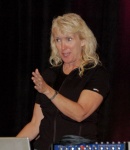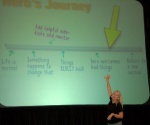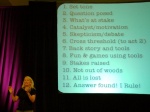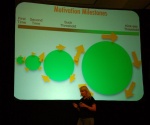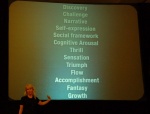Kathy Sierra talks about storyboarding (click to enlarge) |
How do you create riveting technical presentations and user manuals? Tell a story. Kathy Sierra is teaching the tutorial and using her own experience creating the "Head First" books on Java and Design Patterns as examples.
Define your "post-click" behavior. After someone has gotten your message, what would happen in the reader? Does you message change the readers behavior? Do you know how you want it to change them? You can't create the right material without understanding what you want to achieve. In the case of
What creates a page turner? Suspense, for one. The feeling that you can't wait to see what comes next. Or even just the joy of understanding something complex.
What makes you stop turning the page? The audience responds with several examples including jargon, exclusion, competition with funner activities, and so on. Kathy talks about how jargon is an example of something that's good for people to know, but someone has to provide the bridge and too many books suffer from only being understandable after you know the area.
There's a hierarchy of requirements for a "bestseller."
- The right topics
- In the right order
- Clear and accurate
- Interesting
- Enchanting
The competitive advantage is in the final two. Good writers don't usually have a huge challenge with the first three. But you have to nail those first.
One of the biggest problems that technical writers have is contentitis: the need to cover everything. Most books would do better with much less material in the same time. This is related to the happy user peak that Kathy has talked about related to product features.
Good books are brain friendly and seductive. When you can properly introduce people to topics, they get a richer experience. It's important to get people past the suck threshold and above the passion threshold as quickly as possible. That means you need to get information to them quickly. And that means that creating a page-turner is vital.
People don't want to be experts at a tool. They want to get something done, accomplish their goals. People do become passionate about tools, but largely because they allow them to get things done. Kathy uses the Nikon Learning Center as a positive example of focusing on the pictures people want to take and then walking through the ways to use the camera to get those results. Contrast that with user manual which is a dry exposition of features. She takes it one step further and contrasts sales literature with user manuals.
The brain has spam filters. No matter how hard you might want to get some information in your mind, the brain has natural processes that filter out some information as "not important." Authors have to fight to get past the spam filters. Legacy brains have to be fooled into thinking that the topic we want to learn is something they care about.
Brains care about chemistry (i.e. emotion). Brains pay attention to things that have an associated emotional cue. Brains like novelty, weird, different. You should be afraid every moment that you're losing you're reader. Brains pay attention to things that are scary. Brains care about changes in light and shadow. Brains pay attention to faces. Brains like joy. Brains like young cute things.
Brains don't care about cliche. Brains don't like things that aren't resolved. The brain gets pulled in trying to figure things out. Curiosity is irresistible.
Bottom line: emotions tell the brain "this matters." So talk to the brain, not the mind. In other words, trick the brain into thinking polymorphism is as important as a tiger.
Formality is a problem. People's ability to use and apply new information is positively affected by using a conversational tone. She cites research by Moreno and Mayer (here's a good summary) that " research seems to show a self referential effect where information is retained, memorized better when it is given a personal reference."
Biggest lesson: if you're in the business of communicating things, you're in the emotion-delivery business.
Kathy Sierra
talks about the Hero's Journey (click to enlarge) |
Reader as hero. This doesn't mean that you write your book as a fictional story. But you want the reader to identify with the journey and the endpoint goal. The experience should be a hero's journey: life is normal, something happens to change that, (add a helpful sidekicks and mentor), things really suck, hero overcomes bad things, and then, finally, the hero returns to normal. The hero is changes after overcoming bad things. As an author, you should figure out what that change is. This is the outcome that you want for the reader.
The reader as hero can't be supported by "dumbing down" the material. The reader won't feel heroic if the material is too easy. Don't shy away from challenging. But use brain friendliness to create the emotional experience that gets them through the challenge
Here's the overall process we're going to consider.
- Log line
- High level 3-acts
- Create 'story' template
- Create topic list/cards
- Rearrange in template
- Fill in holes
- Do detailed storyboards
- Miracle occurs
The log line answers three questions:
- Who is this about?
- What is he up against?
- What is at stake?
Act one is the call to action. Act one typically ends with the hero's refusal of the call and ultimate acquiescence. Act two is the challenge and ends with figuring out how to meet the challenge. Act three is the road home.
Story templates (click to enlarge) |
Here's the story template:
- Set tone
- Question posed
- What's at stake
- Catalyst or motivation
- Skepticism or debate
- Cross threshold (to Act 2)
- back story and tools
- Fun and games using tools
- Stakes raised
- Not out of woods
- All is lost
- Answer found! I rule!
- Lessons learned
Keep in mind that learning experiences are fundamentally different from reference experiences. You can't create a great leaning tool and make it a great reference too at the same time.
Steps 1-5 in the preceding template are Act 1 and should be about 20-40 pages in a technical book. Steps 6-12 are Act 2 and are usually around 300 pages. Step 13 is the final Act and is again around 20-40 pages.
For every thing in your book from Acts to chapters to parts of chapters, use the spiral user experience model.
Motivational milestones (click to enlarge) |
Ask "why?", "who cares?", and "so what?" about very topic. Make sure this is front loaded so that the brain knows what it should pay attention. Make sure that when you say "This matters because..." that what follows in emotionally engaging. Show, don't tell. This might mean pictures but can also be an example. "Imagine you want to do..." is a way to set up a scenario.
Smoking out the topics with the "who cares?" question can ignite your natural passion about why it matters and affect writing in a positive way. Make this discussion real. Better to do it with a helpful critic, I think.
The other part of the spiral that readers care about is the payoff. Once users understand concept A, that leads right into the motivation for concept B: now that you understand this, you're ready to approach something even better. Game designers are good at this.
A technique for getting emotional benefit is "just in time" vs. "just in case." Just-in-time learning is highly motivated. Just-in-case is what books and lectures are all about. Setting up scenarios with "image you want to ..." is one way to making just-in-case feel like just-in-time. You'll end up with the topics in the right order.

The representation of getting to the next level. What are the rewards someone gets for completing an activity or learning something new? What are the new "superpowers" that they get? What can they do now that they could do before?
We need to get readers in the flow state--that state where they can't stop reading. To get there, knowledge and challenge have to be in balance.
What engages the brain? (click to enlarge) |
These things turn the brain on deeply: discovery, challenge, narrative, self-expression, social framework, cognitive arousal, thrill, sensation, triumph, flow, accomplishment fantasy, and growth. Complete the description: "Learning experience as..." Don't take people outside the experience with extraneous material and narrative. Don't make users think about the wrong things.
Variety is important. We get tired if we hop on one leg over and over. Make sure that you're exercising different parts of the brain. Insert cooler stuff with dry stuff. Pace the topics.
We ended with an exercise of writing out some storyboard ideas for something we care about. I did it for the first product Kynetx is building and it was fun and helpful.

